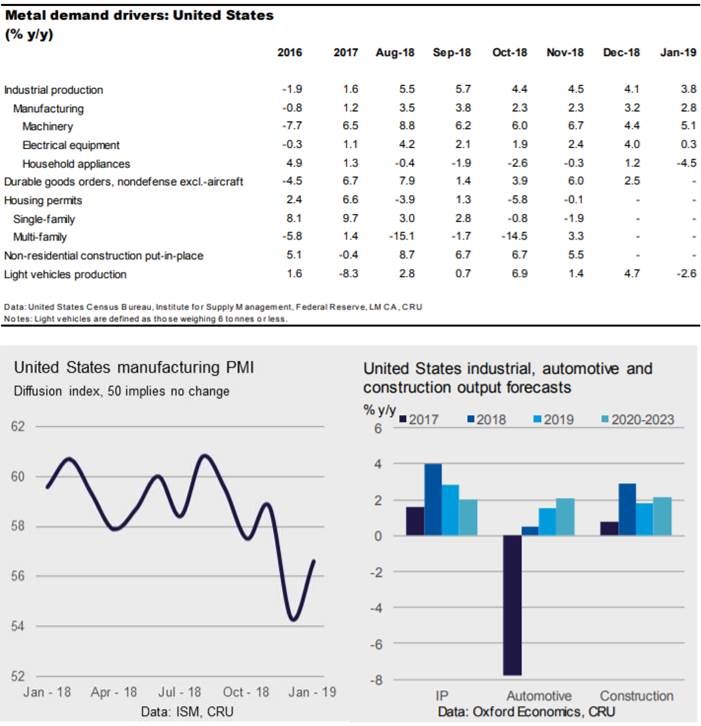Economy

CRU on Metal Demand Drivers in the U.S. Economy
Written by Tim Triplett
February 28, 2019
By CRU Principal Economist Lisa Morrison
U.S. economic data for December and January are beginning to come in now that the federal government is funded for the remainder of this fiscal year, which ends Sept. 30.
December housing starts showed a weak end to 2018 as the total of 1.247 million units for 2018 was lower than we expected by about 20,000 units. Permits data, however, were more encouraging at nearly 1.33 million units, and we note the continuation of strong multifamily activity against a rather lackluster single-family sector. If the December data are indicative of 2019 overall, then our forecast for starts of 1.29 million units this year will hold.
The release of industrial production data was not affected by the shutdown, and the January report indicated that 2019 started off well for both manufacturing and oil & gas. We thus continue to expect IP growth of 2.8 percent this year, down from 3.9 percent in 2018.
Our vehicle production forecast for 2019 is unchanged at ~11.6 million units, but we note that sales have softened and there is downside risk to domestic demand. Speaking of downside risk, the Commerce Department delivered its report on the Section 232 investigation into vehicle imports to President Trump, but did not provide any insight as to the recommendations. The president now has until May 18 to take additional action.
Trade negotiations with China are progressing well enough that President Trump lifted the March 1 deadline for the escalation of tariffs on Chinese imports (to 25 percent). This was good news for the financial markets, and the dollar even weakened a little in response.
A new risk for us to monitor is whether the change in the 2018 tax law requires higher withholding by individuals in 2019, which could translate into lower consumer spending growth this year.


Tim Triplett
Read more from Tim TriplettLatest in Economy

New York state manufacturing index drops again in April
Firms were pessimistic, with the future general business conditions index falling to its second lowest reading in the more than 20-year history of the survey

Construction adds 13,000 jobs in March
The construction sector added 13,000 jobs, seasonally adjusted, in March, but tariffs could undermine the industry.

Supply chains, end-users brace for impact from tariffs
Supply chains are working through what the tariffs mean for them

ISM: Manufacturing expansion loses steam after two months of growth
US manufacturing activity slowed in March after two straight months of expansion, according to supply executives contributing to the Institute for Supply Management (ISM)’s latest report.

Chicago Business Barometer rose to 16-month high in March
The Chicago Business Barometer increased for the third-consecutive month in March. Despite this, it still reflects contracting business conditions, as it has since December 2023.
